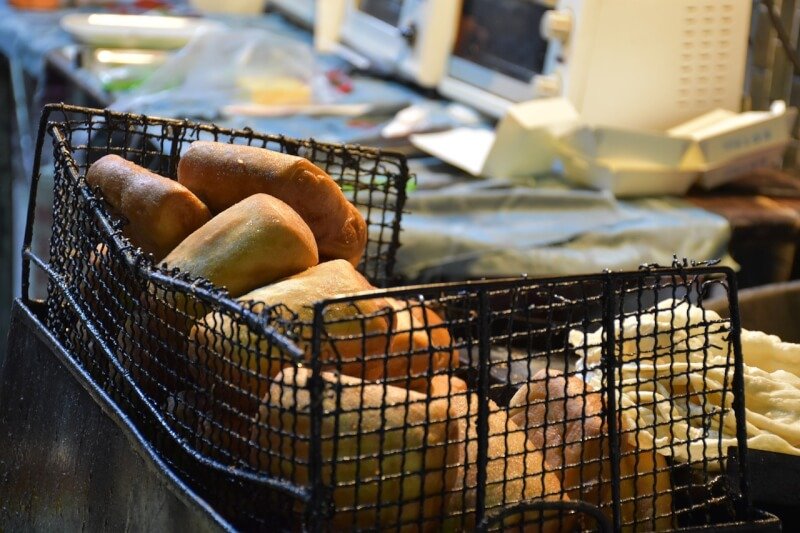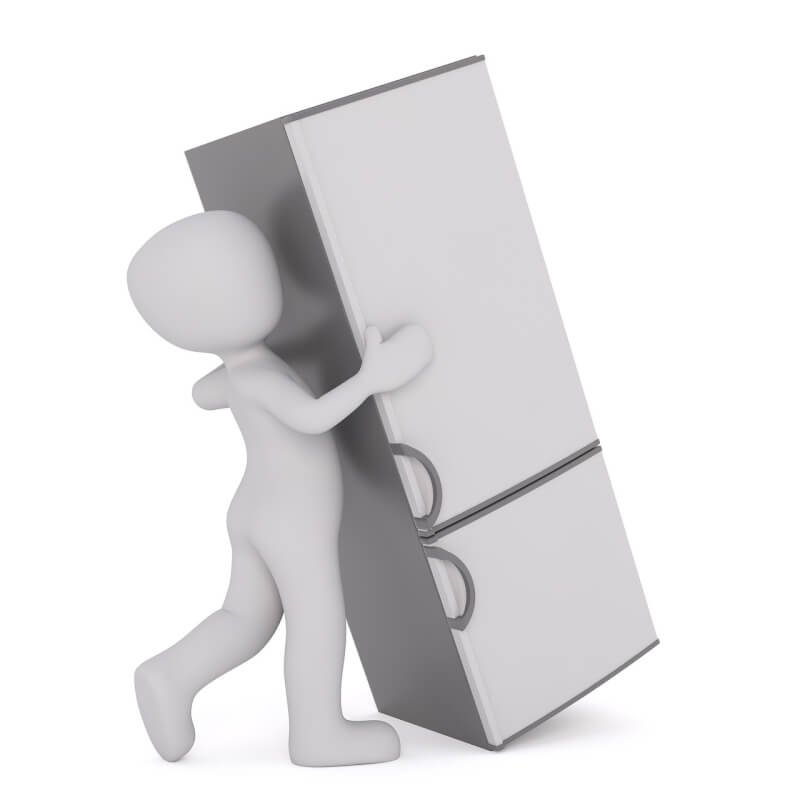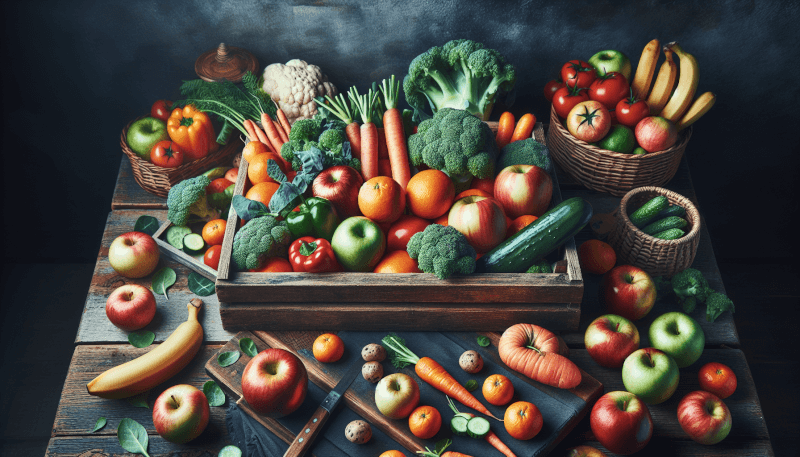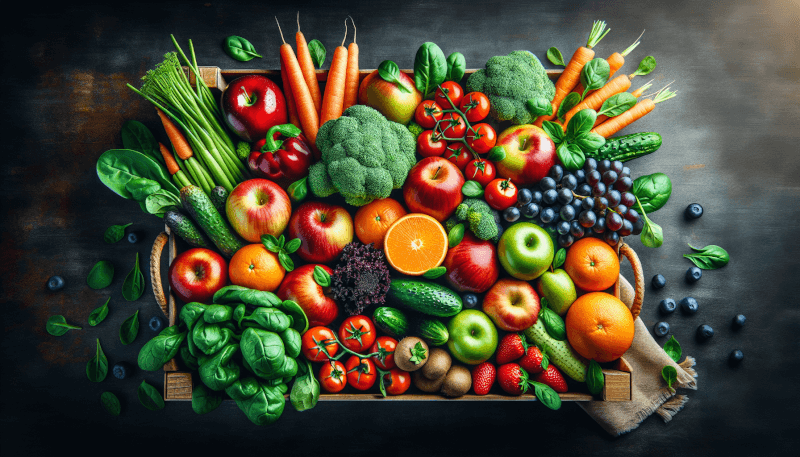In this article, you will discover the best methods for storing fruits and vegetables to keep them fresh for longer periods of time. Whether you have a surplus from your garden or are buying in bulk, learning how to store your produce correctly can help reduce waste and save you money. From understanding the ideal conditions for different types of fruits and vegetables to learning about the best storage techniques, this article will provide you with all the information you need to ensure your fruits and vegetables stay fresher for longer. So let’s get started and make sure your produce stays delicious and nutritious!

Choosing the Right Storage Conditions
When it comes to storing fruits and vegetables, creating the right storage conditions is crucial to ensuring their freshness and preserving their quality for as long as possible. There are several factors to consider when choosing the right storage conditions, including temperature, humidity, light, and air circulation.
Temperature
Temperature plays a key role in determining the shelf life of fruits and vegetables. Most fruits and vegetables prefer cool temperatures, but the ideal temperature may vary depending on the specific type of produce. For example, tropical fruits like bananas and pineapples prefer warmer temperatures, while leafy greens and berries prefer cooler temperatures.
Generally, a temperature of around 40 to 50 degrees Fahrenheit (4 to 10 degrees Celsius) is suitable for storing fruits and vegetables. However, it’s important to note that some produce, such as tomatoes and potatoes, can be negatively affected by cooler temperatures and are better stored at room temperature.
Humidity
Humidity refers to the amount of moisture in the air, and it also plays a crucial role in the proper storage of fruits and vegetables. Some produce, like leafy greens and herbs, prefer higher humidity levels to prevent them from wilting, while others, like apples and onions, prefer lower humidity levels to prevent them from becoming soft or moldy.
It’s generally recommended to store fruits and vegetables in a cool and dry environment with a relative humidity of around 85 to 95 percent. However, it’s important to monitor the humidity levels regularly and make adjustments accordingly to prevent the produce from spoiling.
Light
Light exposure can have a significant impact on the quality and shelf life of fruits and vegetables. Exposure to light can cause certain fruits and vegetables to ripen more quickly or develop off-flavors. Therefore, it’s important to store produce in a dark or dimly lit area, away from direct sunlight or bright artificial lights.
For fruits and vegetables that continue to ripen after being harvested, such as tomatoes and avocados, it’s best to store them at room temperature in a dark place until they reach the desired level of ripeness. Once they are ripe, they can be refrigerated to slow down the ripening process and extend their shelf life.
Air Circulation
Proper air circulation is essential for preventing the build-up of ethylene gas, which is produced naturally by some fruits and vegetables and can accelerate the ripening process of nearby produce. Good air circulation can also help prevent the growth of mold and bacteria, which can cause spoilage.
To ensure adequate air circulation, it’s important to avoid overcrowding the storage space and leave enough room between the produce. This will allow air to circulate freely and help maintain the freshness of the fruits and vegetables.
Preparing Fruits and Vegetables for Storage
Before storing fruits and vegetables, it’s important to properly prepare them to ensure their longevity. By following these steps, you can optimize the storage conditions and prolong the shelf life of your produce.
Washing and Drying
Before storing fruits and vegetables, it’s essential to wash them thoroughly to remove any dirt, bacteria, or pesticides. However, it’s important to keep in mind that excessive moisture can cause premature spoilage. Therefore, it’s important to dry the produce completely before storing.
To dry fruits and vegetables, gently pat them dry with a clean towel or use a salad spinner to remove excess moisture. Once they are completely dry, they are ready to be stored.
Removing Bruised or Damaged Portions
It’s crucial to inspect the produce for any bruises or damaged portions before storing them. Bruised or damaged areas are more prone to spoiling and can accelerate the decay process of the entire fruit or vegetable.
If you come across any bruises or damaged areas, it’s important to cut them out before storing the produce. By removing these damaged portions, you can prevent the spread of bacteria and extend the shelf life of the remaining portions.
Separating Fruits from Vegetables
Fruits and vegetables have different storage requirements due to variations in ethylene production and sensitivity. Ethylene is a natural hormone that some fruits and vegetables release, which can accelerate the ripening process of nearby ethylene-sensitive produce.
To avoid premature ripening and spoilage, it’s important to store fruits and vegetables separately. This will prevent the release of ethylene from certain fruits and vegetables and help maintain the quality and freshness of the produce.
Trimming and Cutting
In some cases, trimming or cutting fruits and vegetables before storage can help prolong their shelf life. For example, removing the tops from root vegetables like carrots and beets can prevent moisture loss and extend their freshness. Trimming off excess leaves from vegetables like radishes and turnips can also help prevent them from wilting.
When it comes to fruits, cutting them into smaller pieces can speed up the ripening process. Therefore, it’s generally best to store fruits whole until ready to consume.
Packaging
Proper packaging is essential for preserving the freshness and quality of fruits and vegetables. When packaging produce, it’s important to choose the right containers or bags that provide adequate airflow and moisture control.
For loose produce like leafy greens and berries, storing them in breathable containers can help prevent moisture buildup and keep them fresh. If using plastic bags, make sure to poke a few holes to allow for proper air circulation.
For fruits and vegetables that release ethylene gas, such as apples and tomatoes, it’s important to store them separately from ethylene-sensitive produce. Wrapping produce in paper or storing them in perforated bags can also help regulate moisture levels and prevent spoilage.

Recommended Storage Methods
There are several storage methods to choose from when it comes to preserving fruits and vegetables for the long term. Each method has its own advantages and considerations, and it’s important to select the one that best suits your needs and the specific produce you are storing.
Refrigeration
Refrigeration is one of the most common and effective methods of storing fruits and vegetables. The cool temperature helps slow down the ripening process and inhibit bacterial growth, extending the shelf life of produce.
Leafy greens, berries, and delicate vegetables like cucumbers and zucchini are best stored in the refrigerator. However, it’s important to keep in mind that not all produce is suited for refrigeration. Tomatoes, potatoes, and onions, for example, are better stored outside the refrigerator to maintain their flavor and texture.
Root Cellar
A root cellar is a traditional storage method used to keep fruits and vegetables fresh for extended periods. Root cellars provide a cool, dark, and humid environment, which is ideal for storing root vegetables, potatoes, and other hardy produce.
If you have a basement or a cool and dark area in your house, you can create a makeshift root cellar by storing the produce in bins, boxes, or crates covered with damp sand, sawdust, or straw to maintain humidity levels.
Canning
Canning is a preservation method that involves packing fruits and vegetables into jars and sealing them for long-term storage. The canning process involves boiling the jars to kill bacteria and create a vacuum seal, which prevents spoilage.
Canning is a great option for produce that is in abundance during certain seasons, as it allows you to enjoy the flavors and nutrients of fruits and vegetables all year round. It’s important to follow proper canning techniques and recipes to ensure the safety and quality of the preserved produce.
Freezing
Freezing is another popular method of preserving fruits and vegetables for the long term. By freezing produce, you can lock in their nutrients and flavors, allowing you to enjoy them later.
To freeze fruits and vegetables, it’s important to blanch them first to kill bacteria and enzymes that can cause loss of color, flavor, and texture. Once blanched, the produce should be spread out on a baking sheet and frozen individually before being transferred to airtight containers or freezer bags.
Dehydrating
Dehydrating is a method of removing moisture from fruits and vegetables to extend their shelf life. This can be done using a food dehydrator, an oven, or by air-drying.
Dehydrated fruits and vegetables make for convenient and nutritious snacks, and they can also be used to add flavor and texture to a variety of dishes. It’s important to store dehydrated produce in airtight containers in a cool and dark place to prevent moisture absorption.
Vacuum Sealing
Vacuum sealing is a method of storing fruits and vegetables in airtight bags to remove air and prevent spoilage. Vacuum sealing can help prolong the shelf life of produce by preventing the growth of mold, bacteria, and oxidation.
When vacuum sealing fruits and vegetables, it’s important to ensure they are completely dry to prevent the growth of bacteria. Properly sealed bags should be stored in a cool and dark place to maintain the quality and freshness of the produce.
Specific Fruits Storage Guidelines
Different fruits have distinct storage requirements due to variations in their ripening process, ethylene production, and sensitivity to temperature and humidity. Here are some specific storage guidelines for popular fruits:
Apples
Apples should be stored in a cool place, preferably in the refrigerator. They can be kept in a perforated plastic bag or wrapped in a paper towel to maintain humidity levels.
Bananas
Bananas should be stored at room temperature until they reach the desired level of ripeness. Once ripe, they can be refrigerated to extend their shelf life.
Oranges
Oranges can be stored at room temperature for a few days, but they will last longer in the refrigerator. It’s best to store them in a perforated plastic bag to maintain moisture levels.
Berries
Berries are delicate and perishable, and they should be consumed or used as soon as possible. If they need to be stored, they should be refrigerated in a breathable container lined with paper towels to absorb excess moisture.
Grapes
Grapes should be stored in the refrigerator, and they can last up to two weeks. It’s best to store them in a breathable container or perforated plastic bag to maintain humidity levels.
Pineapples
Pineapples should be stored at room temperature until they reach the desired level of ripeness. Once ripe, they can be refrigerated for a few days.
Melons
Melons should be stored at room temperature until they are fully ripe. Once ripe, they can be refrigerated to extend their shelf life.
Avocados
Avocados should be stored at room temperature until they are ripe. Once ripe, they can be refrigerated to slow down the ripening process.
Tomatoes
Tomatoes should be stored at room temperature away from direct sunlight. It’s best not to store them in the refrigerator, as it can affect their flavor and texture.

Specific Vegetables Storage Guidelines
Like fruits, different vegetables have specific storage requirements to maintain their freshness and quality. Here are some guidelines for storing popular vegetables:
Leafy Greens
Leafy greens such as lettuce, spinach, and kale should be refrigerated in a breathable container or plastic bag to prevent wilting. It’s also recommended to wash and dry them thoroughly before storing.
Root Vegetables
Root vegetables like carrots, beets, and radishes should be stored in a cool, dark, and humid environment. It’s important to remove the tops and store them in perforated plastic bags or covered containers to maintain humidity levels.
Cruciferous Vegetables
Cruciferous vegetables like broccoli, cauliflower, and cabbage should be stored in the refrigerator in a breathable container or plastic bag. It’s best to wrap them in a damp paper towel to maintain humidity levels.
Peppers
Peppers can be stored at room temperature for a few days, but they will last longer in the refrigerator. It’s best to store them in a breathable container or perforated plastic bag.
Onions
Onions should be stored in a cool, dry, and dark place with good air circulation. It’s important to keep them separate from other produce to prevent their strong odors from affecting nearby items.
Garlic
Garlic should be stored in a cool, dry, and dark place. It’s best to store them in a mesh bag or a container with good airflow to prevent moisture buildup.
Potatoes
Potatoes should be stored in a cool, dark, and humid place, preferably a root cellar or a cool basement. It’s important to keep them away from light to prevent them from turning green and becoming toxic.
Carrots
Carrots should be stored in a cool, dark, and humid place to prevent them from drying out. It’s best to remove the tops and store them in perforated plastic bags or covered containers to maintain humidity levels.
Cucumbers
Cucumbers should be stored in the refrigerator in a breathable container or plastic bag. It’s important to keep them away from ethylene-producing fruits and vegetables to prevent premature spoilage.
Zucchini
Zucchini should be stored in the refrigerator in a breathable container or plastic bag. It’s best to use them within a few days to maintain their flavor and texture.
Monitoring and Rotating Stock
To ensure the freshness and quality of stored fruits and vegetables, it’s important to monitor them regularly and rotate the stock. Here are some tips on how to effectively monitor and rotate your produce:
Checking Regularly
Regularly check the stored produce for any signs of spoilage, such as mold, soft spots, or foul odors. If you come across any spoiled items, remove them immediately to prevent the spread of bacteria.
Discarding Spoiled Items
If you find any spoiled fruits or vegetables, it’s important to discard them properly. Spoiled produce can contaminate other items, so it’s best to dispose of them in a compost bin or as directed by your local waste management guidelines.
Using First-In-First-Out (FIFO) Method
To ensure that your produce is consumed or used in a timely manner, it’s a good practice to follow the First-In-First-Out (FIFO) method. This means using or consuming the oldest produce first to minimize waste and ensure that nothing goes bad.

Tips for Prolonging Shelf Life
In addition to proper storage and preparation, there are some additional tips that can help prolong the shelf life of your fruits and vegetables:
Avoiding Moisture
Excess moisture can cause fruits and vegetables to spoil quickly. To prevent moisture buildup, make sure to wash and dry produce thoroughly before storage. Using a salad spinner or gently patting them dry with a clean towel can help remove excess moisture.
Keeping Vegetables Whole
Cutting vegetables before storage can accelerate the ripening process and lead to faster spoilage. It’s best to store vegetables whole and cut them just before use to maintain their freshness.
Storing in Dark Places
Exposure to light can cause certain fruits and vegetables to deteriorate quickly. To prolong their shelf life, store produce in a cool and dark place, away from direct sunlight or bright artificial lights.
Adding Ventilation
Proper air circulation is crucial for preventing the growth of mold and bacteria. Make sure to avoid overcrowding the storage space and leave enough room between the produce to allow for proper ventilation.
Using Ethylene-Producing Fruits
Certain fruits, such as apples and bananas, produce ethylene gas, which can accelerate the ripening process of nearby produce. If you want to speed up the ripening of certain fruits or vegetables, you can store them with ethylene-producing fruits. However, for the best results, it’s generally recommended to store ethylene-producing fruits separately from ethylene-sensitive produce.
Common Mistakes to Avoid
Even with the best intentions, there are some common mistakes that can affect the longevity of your stored fruits and vegetables. By avoiding these mistakes, you can ensure the freshness and quality of your produce:
Storing Different Fruits and Vegetables Together
As mentioned earlier, fruits and vegetables have different storage requirements due to variations in ripening process and ethylene production. Storing different types of produce together can result in premature ripening or spoilage. It’s best to store fruits and vegetables separately to maintain their freshness.
Exposing to Excessive Cold
While refrigeration is an effective method for storing many fruits and vegetables, some produce is negatively affected by excessive cold. Tomatoes, potatoes, and onions, for example, are best stored at room temperature to maintain their flavor and texture. It’s important to understand the optimal storage conditions for each type of produce.
Using Plastic Bags
Plastic bags are commonly used for storing fruits and vegetables, but they can trap moisture and promote bacterial growth. If using plastic bags, make sure to poke a few holes for proper air circulation. Alternatively, you can use breathable containers or bags specifically designed for storing produce.
Leaving Tops On Root Vegetables
Leaving the tops on root vegetables can cause moisture loss and accelerate spoilage. It’s best to remove the tops before storage to prevent wilting and maintain the freshness of the roots.
Ignoring Warning Signs
Regularly inspecting and monitoring the stored produce is essential for catching any warning signs of spoilage. If you notice any mold, soft spots, or foul odors, it’s important to take immediate action to prevent the spread of bacteria and preserve the quality of the remaining produce.

Resources for Further Information
If you want to dive deeper into the world of storing fruits and vegetables, there are several resources available to expand your knowledge. Here are some recommended books, websites, and videos:
Books
- “The Vegetable Gardener’s Bible” by Edward C. Smith
- “Root Cellaring: Natural Cold Storage of Fruits & Vegetables” by Mike and Nancy Bubel
- “Preserving Food Without Freezing or Canning” by the Gardeners and Farmers of Terre Vivante
Websites
- National Center for Home Food Preservation (nchfp.uga.edu)
- University of California Postharvest Technology Center (postharvest.ucdavis.edu)
- The Spruce Eats (thespruceeats.com)
Videos
- “How to Store Fruits and Vegetables to Keep Them Fresh” by Clean My Space
- “Storing Fruits and Vegetables for Extended Freshness” by Home & Garden TV
Conclusion
Properly storing fruits and vegetables is essential for extending their shelf life and maintaining their quality. By considering factors such as temperature, humidity, light, and air circulation, you can create the ideal storage conditions for your produce.
With the right storage methods and proper preparation, you can enjoy the flavors and nutritional benefits of your favorite fruits and vegetables for an extended period. By avoiding common mistakes and following recommended guidelines, you can make the most of your produce and reduce food waste.
Remember to regularly monitor your stored produce, discard any spoiled items, and use the FIFO method to ensure optimal freshness. By following these tips and utilizing the resources available, you can become a pro at storing fruits and vegetables for long-term storage. So go ahead, stock up on your favorite produce, and enjoy their freshness year-round!


